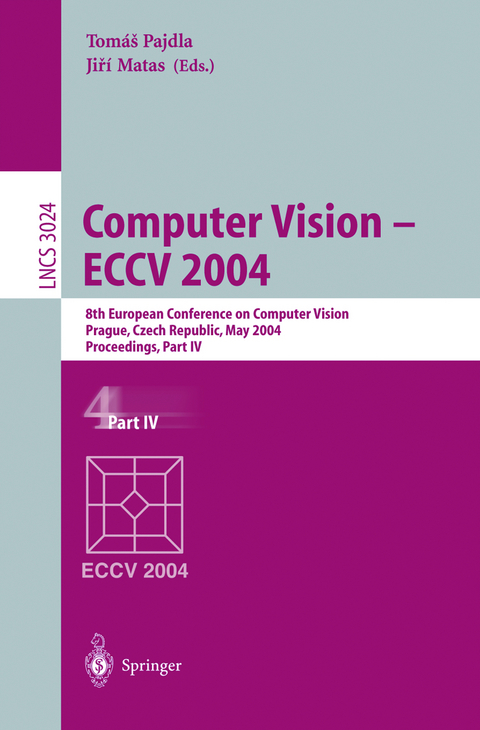
Computer Vision - ECCV 2004
Springer Berlin (Verlag)
978-3-540-21981-1 (ISBN)
Scale Space, Flow, Restoration.- A l 1-Unified Variational Framework for Image Restoration.- Support Blob Machines.- High Accuracy Optical Flow Estimation Based on a Theory for Warping.- Model-Based Approach to Tomographic Reconstruction Including Projection Deblurring. Sensitivity of Parameter Model to Noise on Data.- 2D Shape Detection and Recognition.- Unlevel-Sets: Geometry and Prior-Based Segmentation.- Learning and Bayesian Shape Extraction for Object Recognition.- Multiphase Dynamic Labeling for Variational Recognition-Driven Image Segmentation.- Posters IV.- Integral Invariant Signatures.- Detecting Keypoints with Stable Position, Orientation, and Scale under Illumination Changes.- Spectral Simplification of Graphs.- Inferring White Matter Geometry from Diffusion Tensor MRI: Application to Connectivity Mapping.- Unifying Approaches and Removing Unrealistic Assumptions in Shape from Shading: Mathematics Can Help.- Morphological Operations on Matrix-Valued Images.- Constraints onCoplanar Moving Points.- A PDE Solution of Brownian Warping.- Stereovision-Based Head Tracking Using Color and Ellipse Fitting in a Particle Filter.- Parallel Variational Motion Estimation by Domain Decomposition and Cluster Computing.- Whitening for Photometric Comparison of Smooth Surfaces under Varying Illumination.- Structure from Motion of Parallel Lines.- A Bayesian Framework for Multi-cue 3D Object Tracking.- On the Significance of Real-World Conditions for Material Classification.- Toward Accurate Segmentation of the LV Myocardium and Chamber for Volumes Estimation in Gated SPECT Sequences.- An MCMC-Based Particle Filter for Tracking Multiple Interacting Targets.- Human Pose Estimation Using Learnt Probabilistic Region Similarities and Partial Configurations.- Tensor Field Segmentation Using Region Based Active Contour Model.- Groupwise Diffeomorphic Non-rigid Registration for Automatic Model Building.- Separating Transparent Layers through Layer Information Exchange.- Multiple Classifier System Approach to Model Pruning in Object Recognition.- Coaxial Omnidirectional Stereopsis.- Classifying Materials from Their Reflectance Properties.- Seamless Image Stitching in the Gradient Domain.- Spectral Clustering for Robust Motion Segmentation.- Learning Outdoor Color Classification from Just One Training Image.- A Polynomial-Time Metric for Attributed Trees.- Probabilistic Multi-view Correspondence in a Distributed Setting with No Central Server.- Monocular 3D Reconstruction of Human Motion in Long Action Sequences.- Fusion of Infrared and Visible Images for Face Recognition.- Reliable Fiducial Detection in Natural Scenes.- Light Field Appearance Manifolds.- Galilean Differential Geometry of Moving Images.- Tracking People with a Sparse Network of Bearing Sensors.- Transformation-Invariant Embedding for Image Analysis.- The Least-Squares Error for Structure from Infinitesimal Motion.- Stereo Based 3D Tracking and Scene Learning, Employing Particle Filtering within EM.- 3D Shape Representation and Reconstruction.- The Isophotic Metric and Its Application to Feature Sensitive Morphology on Surfaces.- A Closed-Form Solution to Non-rigid Shape and Motion Recovery.- Stereo Using Monocular Cues within the Tensor Voting Framework.- Shape and View Independent Reflectance Map from Multiple Views.
| Erscheint lt. Verlag | 28.4.2004 |
|---|---|
| Reihe/Serie | Lecture Notes in Computer Science |
| Zusatzinfo | XXVIII, 624 p. |
| Verlagsort | Berlin |
| Sprache | englisch |
| Maße | 155 x 235 mm |
| Gewicht | 740 g |
| Themenwelt | Informatik ► Grafik / Design ► Digitale Bildverarbeitung |
| Mathematik / Informatik ► Informatik ► Software Entwicklung | |
| Informatik ► Theorie / Studium ► Künstliche Intelligenz / Robotik | |
| Schlagworte | 3D • 3D Reconstruction • Active contour • Bildbearbeitung • camera calibration • Classifier SYstems • Cognition • Computational Geometry • computer vision • Computervision • Geometric Computation • Hardcover, Softcover / Informatik, EDV/Informatik • HC/Informatik, EDV/Informatik • Image Analysis • Image Processing • learn • learning • motion tracking • Mustererkennung • Object recognition • optical flow • shape reconstruction • Stereo • Stereo Vision • Vision Algorithms • vision systems |
| ISBN-10 | 3-540-21981-1 / 3540219811 |
| ISBN-13 | 978-3-540-21981-1 / 9783540219811 |
| Zustand | Neuware |
| Informationen gemäß Produktsicherheitsverordnung (GPSR) | |
| Haben Sie eine Frage zum Produkt? |
aus dem Bereich


